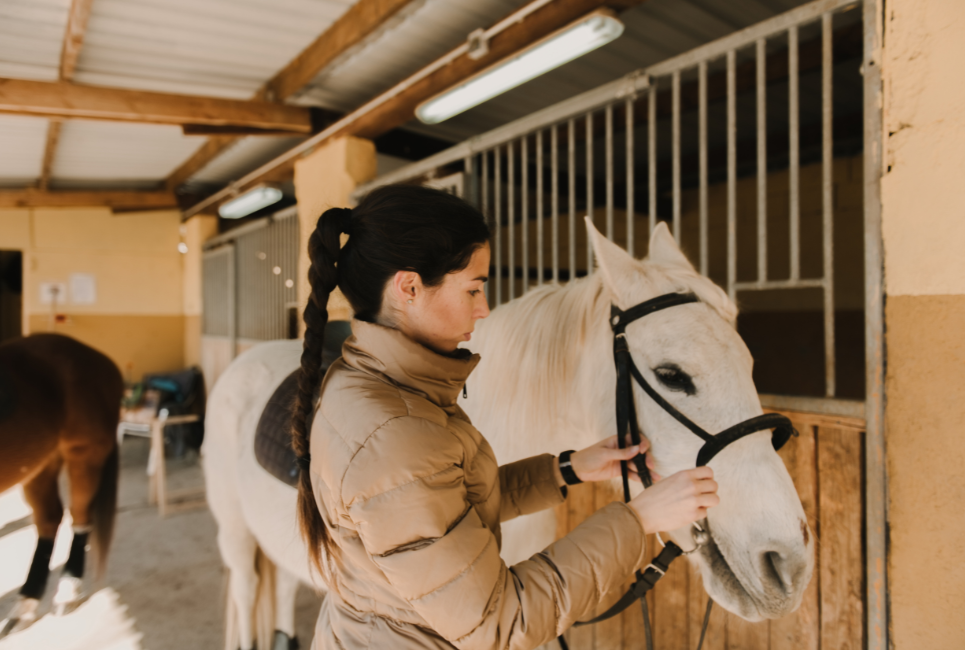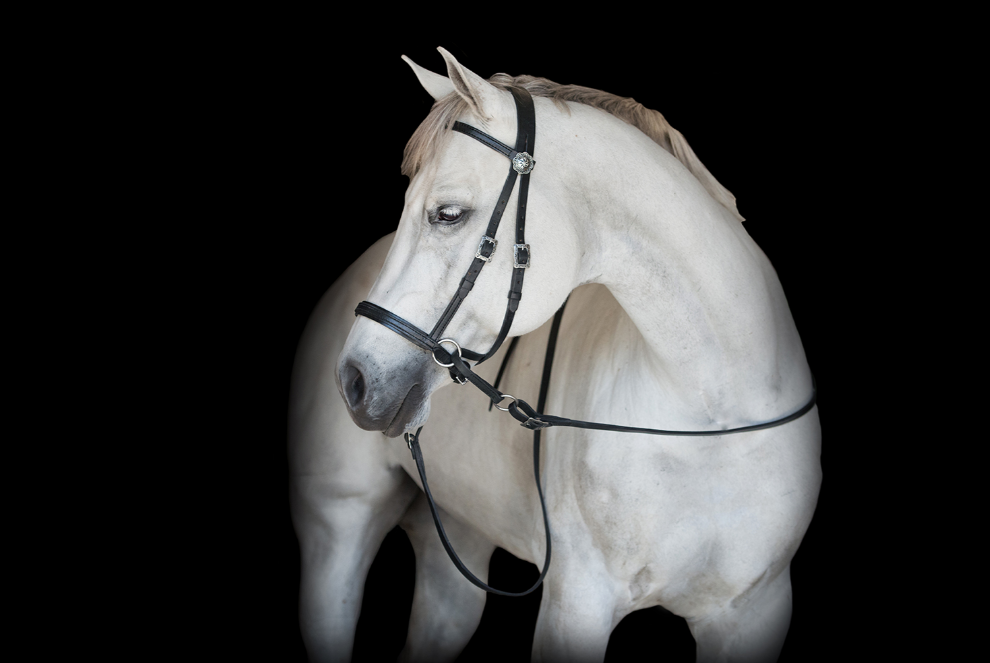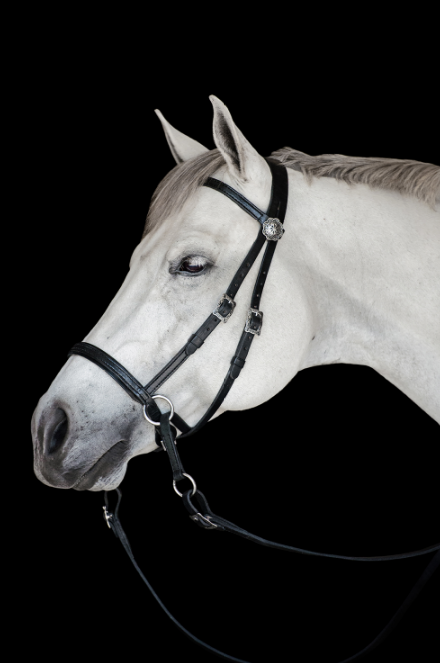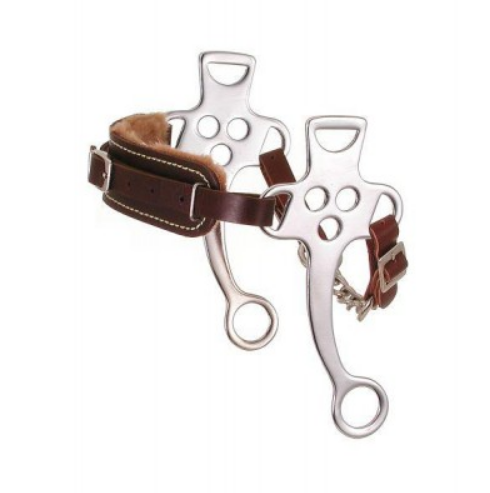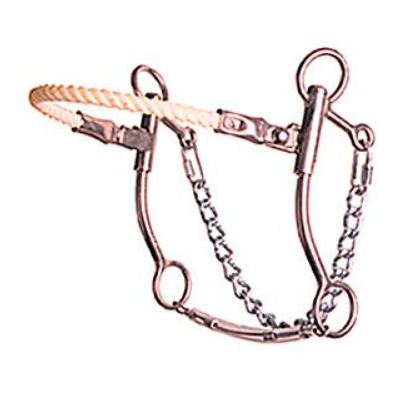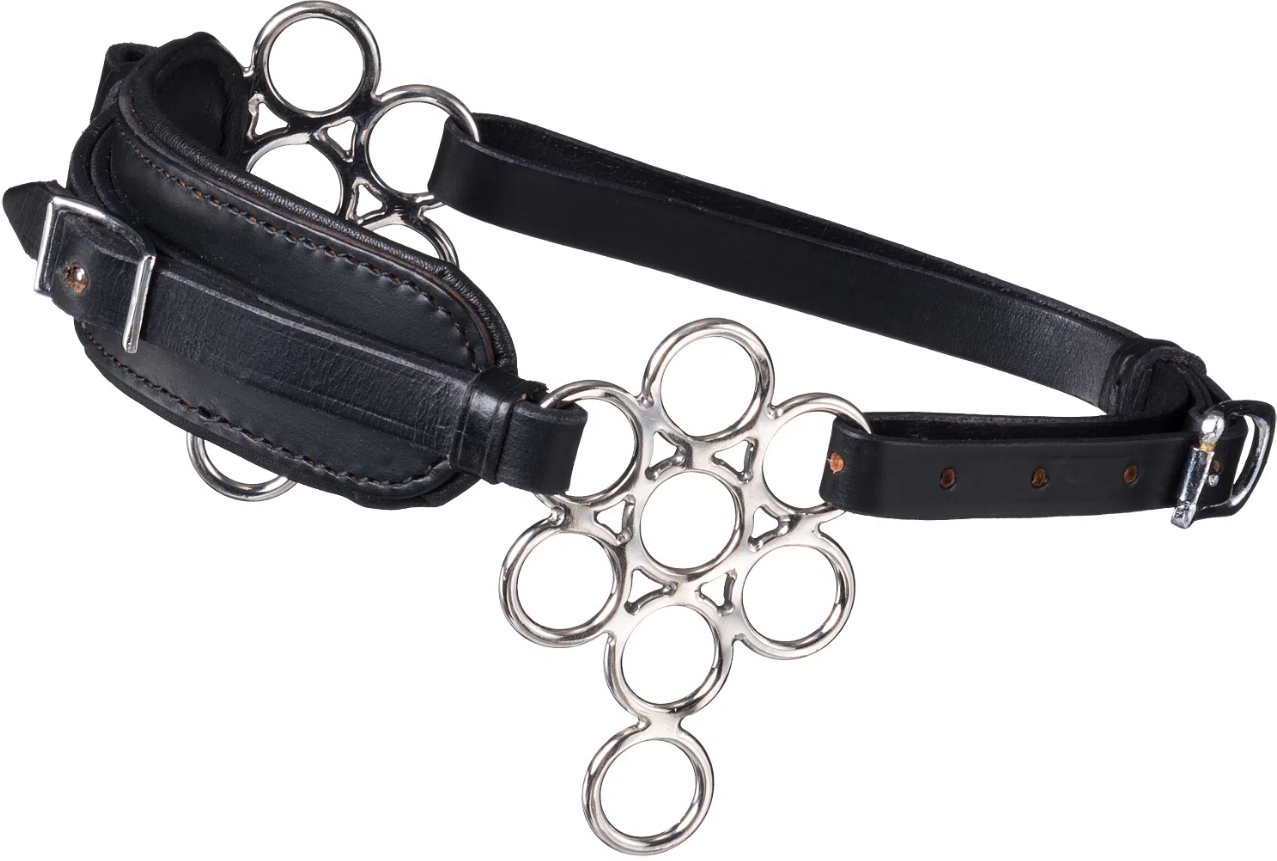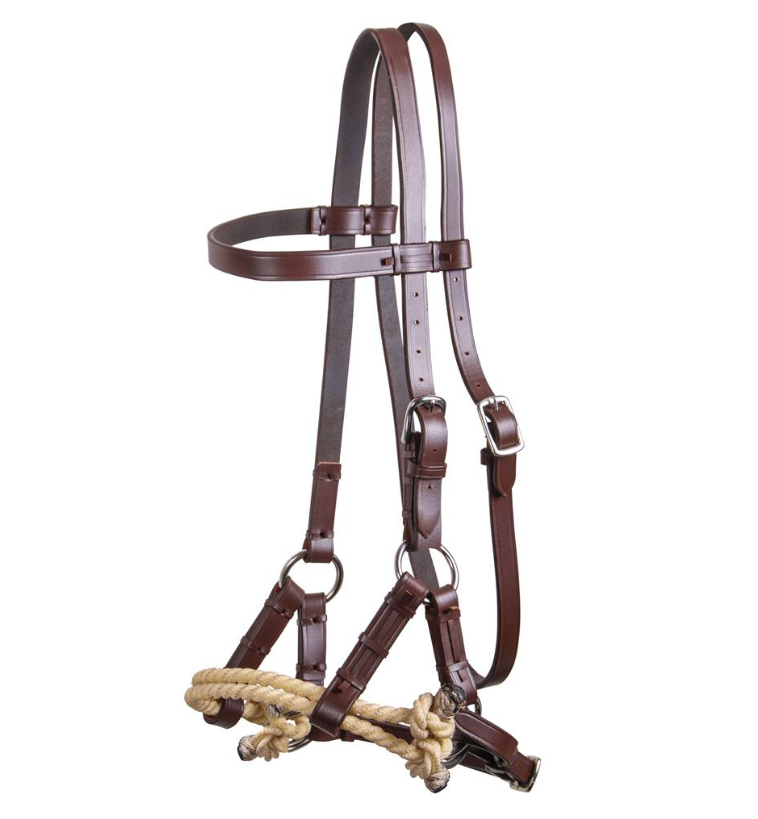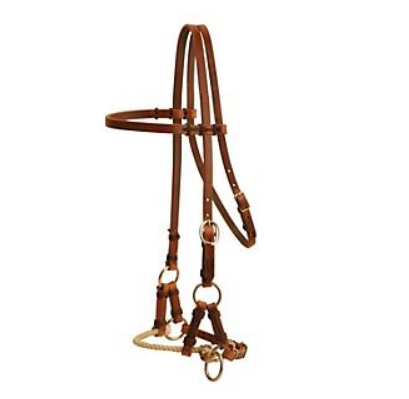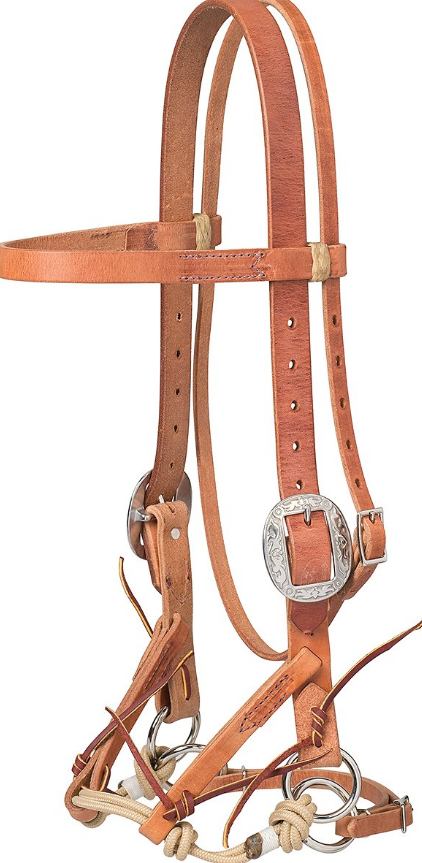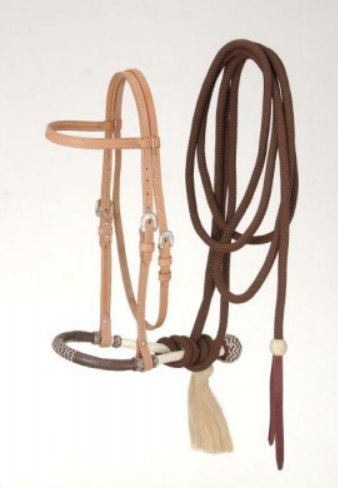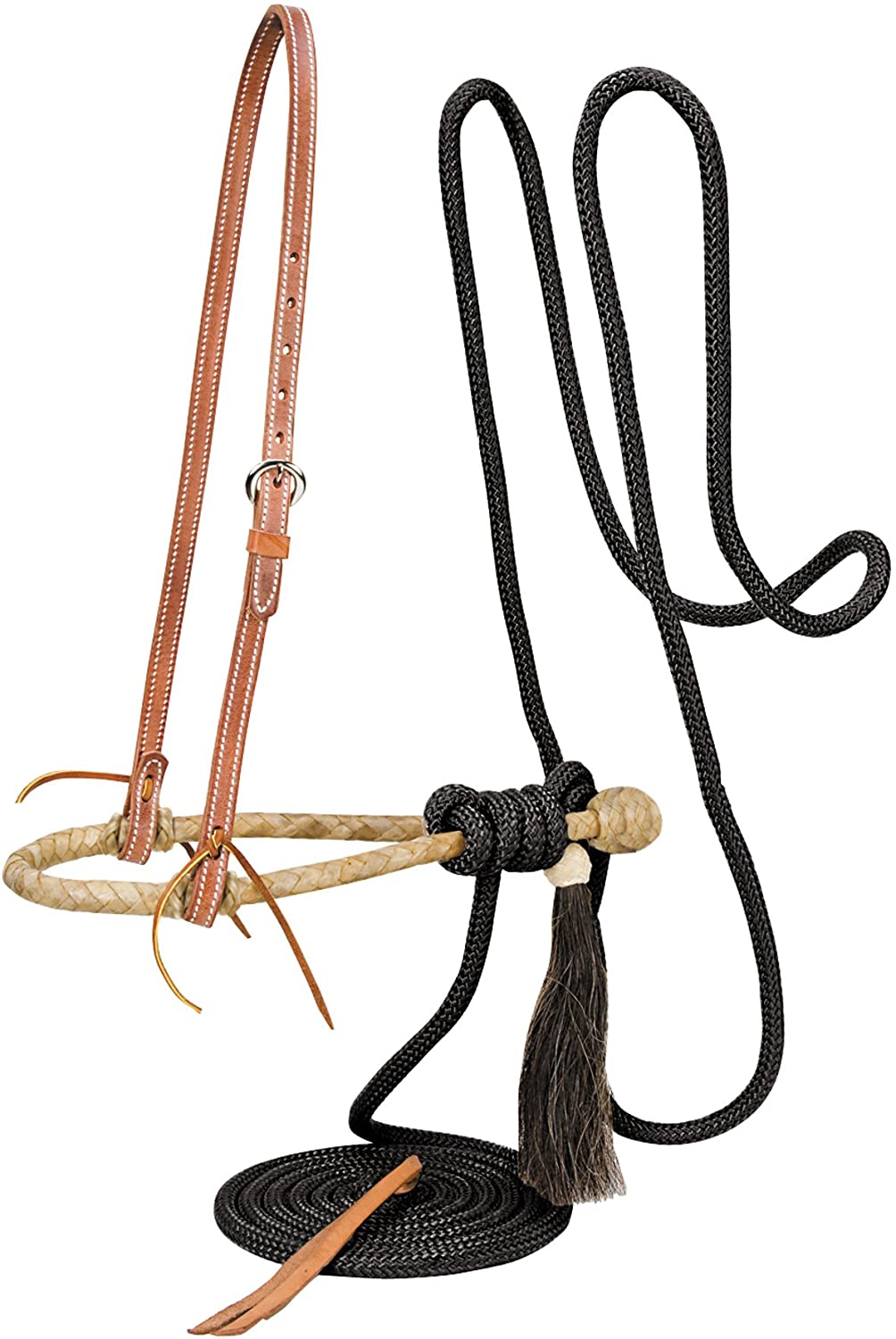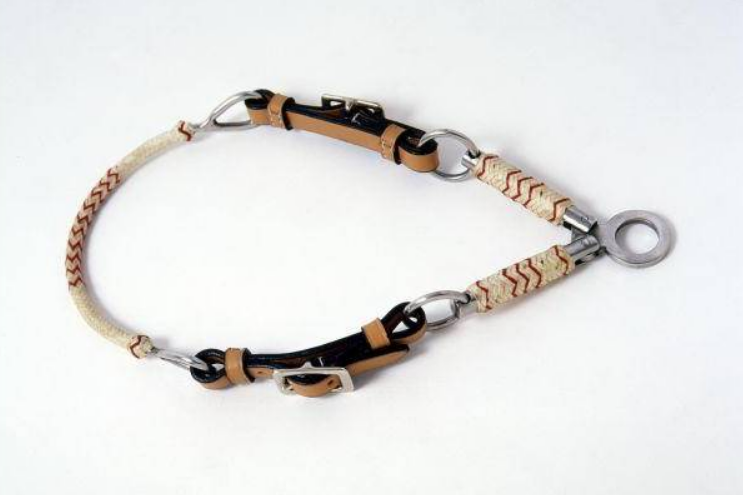- Best Horse Show Halters Guide - July 13, 2022
- Best Bareback Pads Guide - July 5, 2022
- Best Western Bitless Bridle Guide - July 3, 2022
- Bottom Line Up Front
- How I Chose the Best Bitless Bridles
- How the Western Bitless Bridle Works
- The Best Western Bitless Bridles by Type
- The Hackamore
- Kelly Silver Star Fleece Lined Hackamore
- Reinsman Jim Warner SS Rope Nose Hackamore
- Tough-1 Leather Nose Multi-Ring Hackamore
- The Side-Pull
- Double S Double Rope Side Pull
- Tory Harness Leather Rope Side-Pull
- The Bitless Bridle (Or the Cross-Under)
- Weaver Leather Justin Dunn Bitless Horse Bridle
- Robert Cook's Deluxe Western Headstall
- The Bosal
- Royal King Brow Band Headstall Bosal/Cotton Cord Mecate Set
- Weaver Leather Bosal Set
- Royal King Adjustable Scissor Bosal
- Is a Bitless Bridle Right for Me?
- Who Needs a Bit
- Best Western Bitless Bridle Guide: FAQs
In the western world, we love a bitless bridle. These bridles fit well with our riding style, and we love showing off as much of our horse’s face, uninhibited by bit or leather, as possible. You may not always hear us call it one because we always have to have a cooler-sounding name for everything.
Western riders have several options when it comes to the bitless bridle. There’s the bosal, the side pull, the hackamore, and the western bitless bridle.
I grew up riding really hot horses. I was a barrel racer and overall thrill seeker, and so were my horses. You may not think I would have any room in my tack room for a bitless bridle, but each horse had one hanging next to their “work” bridle.
I always rode my horses in a hackamore and then a bitless bridle on the trail. With a bit of training and a lot of faith; my brakes usually worked well, and the benefit of getting a bit out of their mouth for half of their rides was easy to see.
As I trained in and out of the ring, I started eyeballing even bosals for my ponies. I believe every western rider should consider a bitless bridle (including hackamores, bosals, and side-pulls), even just for the occasional change of pace. They contribute drastically to keeping your horse from resenting its normal bit, and you may find you make a permanent switch.
Bottom Line Up Front
My favorite western bitless bridle is the Weaver Leather Justin Dunn Bitless Horse Bridle. I wish this one was around when I was riding; it’s the perfect blend of western style, decent price point, and functionality. Its clever design will give you just enough communication power while still being one of the most gentle options for a bridle on the market.
How I Chose the Best Bitless Bridles
I used a lot of bitless bridles in my barn, and it’s incredible how many simply don’t do what they’re advertised to do. For this reason, my number one consideration was functionality. Why buy a fancy chunk of leather that can’t deliver?
Bridles serve the most important purpose of your tack: they communicate your wishes to your equine partner. Without the aid of a bit, the bridle must do all of this work for you. Poor design plagues bitless bridles and hardware because it is not easy to design a good bitless bridle.
After functionality, I looked for quality components and affordability. I also did not include hackamores that could produce inhumane amounts of leverage in the wrong hands. I have nothing against these products, but if you are experienced enough to use them, you’ll know what you’re looking for. I did not want a beginner to find a potentially dangerous product on this list.
How the Western Bitless Bridle Works
If you’ve ridden both styles, you know that typically western riders pride themselves on less contact with their horse’s mouth. The horses are taught to neck rein and leg yield as a standard so their owners can keep long, loose, and casual on their reins.
Because of this facet of our riding style, our bridles can work in various ways that aren’t simply direct contact with a bit. Each type of bitless bridle takes advantage of a different aspect of this training. Still, the overall gist is that a bitless bridle asks the horse with pressure instead of telling the horse with force.
You should always try your first bitless bridle in the relative safety of a round pen or ring, and pay special attention to fitting the bridle correctly. Due to the missing bit, they are lacking in the “Woah” department. You’ll likely need to do quite a bit of training and adjusting in a safe environment before loping out to the trailhead.
Depending on the type of bitless bridle, you may or may not need to teach your horse how to neck rein. You will need to teach your horse a verbal “Woah” and a seated “Woah,” and let them get used to what your turning commands will feel like now without the bit.
The Best Western Bitless Bridles by Type
There are four main types of western bitless bridle. All use pressure to communicate with your horse in place of a bit, but all four work in slightly different ways.
I’ve listed the categories in the order I would personally try them out as a beginner with a horse used to a bit. I assessed this by how quickly my horses and I have been able to practically use each, but keep in mind beginners can use any. Hackamores must be selected for beginners with care.
The Hackamore
I would suggest your horse knows how to neck rein if you purchase a long shank hackamore. However, other than that requirement, this bridle type can take very little training for many but the hottest horses.
The long shanks on the hackamore mean that riders can apply a large amount of pressure on both the curb strap and the nose for braking power. This means that a hackamore can be just as severe as a bit due to the leverage some can apply in the wrong hands.
However, this does not mean they are a cruel or ineffective transition tool. Many are designed to be the perfect starter bitless bridle, with multiple ring choices on the shank and up the bridle. These choices allow beginners to start with as much pressure as they need to learn safely and efficiently move their reins up the hardware until they practically apply no pressure to their horse’s face.
The hackamore may not be allowed in your discipline because it is a “leverage” bit. However, you may still consider it a helpful tool.
Kelly Silver Star Fleece Lined Hackamore
This piece of hardware is my favorite all-around western hackamore. The severity of a hackamore is determined by its shank length and curb leverage, as well as its noseband and curb material and width. With a wide sheep nose band, neutrally positioned chain curb, and medium-length shank, this hackamore is the perfect middle ground for working a horse without a bit.
You may need extra training to use this hackamore over harsher options, but isn’t that the point of removing the bit? Please make no mistake; the shank and curb chain will give beginners enough stopping power when they have to use it.
While this hackamore doesn’t include a bridle, it’s still at a decent price point, especially if you find it on sale. At retail ~$40, though, it’s well priced for any “bit.” The leather and sheepskin nose band will look great with the chrome-plated hardware and your horse’s now bitless mouth.
Pros
- Great, middle ground hackamore for beginners or as an all-around bitless option
- Gentle and wide sheepskin noseband
- Medium shank for decent stopping power
- A short chain curb with neutral leverage
- An inexpensive “bit” choice that can be used on your current bridle
Cons
- No matching bridle
- No color options or guaranteed color
- Chrome plated
Reinsman Jim Warner SS Rope Nose Hackamore
I said I was a barrel racer; there’s no way I wasn’t putting this one on the list. If you compete in gymkhana or just like to make an agility course out of your local trails, consider this hackamore as your one-stop-shop for your bitless bridle needs. Jim Warner invented this hackamore in the 90s, and it is by far the most popular barrel racing bitless bridle. I was scared to take my hackamore from the trail to the rodeo, but hackamores like this bridge the gap.
The light rope noseband and chain curb align with what you may be looking for in a flexible, athletic western hackamore, but the swiveling short shank is what sets this piece of hardware apart. Jim was tired of not being able to side pull on a shanked hackamore, so he asked Reinsman to make him a hackamore with a swivel shank, and the rest is history.
While you’ll still predominantly neck rein on your hackamore around the barrels, the added side pull functionality due to its swivel shank puts this hackamore a cut above the rest.
Pros
- Best barrel racing or athletic western bitless bridle
- Swivel shank for more effective side-pull steering
- Rope band molds to nose for good communication and lightweight control
- Short shank and moderately leveraged curb, still a kind hackamore even under pressure
Cons
- Training is required for effective use
- Expensive; expect to pay $100+
- It does not come with a bridle
Tough-1 Leather Nose Multi-Ring Hackamore
This hackamore is a perfect example of why hackamores are a great beginner bitless bridle. While it’s still a leverage bit, the multi-ring design means that you’ll get to choose your leverage until you’re working with next to none. The broad leather nose band and leather curb strap are very mild and will only apply significant pressure when the bottom ring is used.
This is a great hackamore for ponies who haven’t learned to neck rein, as even the longest setting on the shank won’t interfere too much with traditional steering. You won’t have much “whoa” with this hackamore, even with the shank on the longest setting, so be prepared to spend some time in the training ring.
Pros
- Solid leather construction
- Wide leather nose band and curb – a very kind hackamore
- Multiple rings to adjust shank leverage, great for working up to harder bitless bridles
- Multiple rings in a flower design also allow better fit overall
- Very cheap “bit,” as low as $20
Cons
- It only comes in black and looks a little “English.”
- Requires quite a bit of training for safe use
- Runs small
The Side-Pull
Cowboys traditionally used the side pull for training green horses to yield their heads. These horses may not have even been under saddle yet, but they needed to learn how to allow their heads to be pulled and directed. These bridles made it possible to teach this concept without applying a bit, but more easily than a halter.
Now that bitless bridles have taken off, many find they work well as a permanent bitless bridle solution for their horse. Side pulls work by running a line from one side of the horse’s nose to the other. As the name suggests, you do not need neck rein to use a side pull, though you can.
Instead, pulling only on one rein pulls the line across their nose to help add pressure to your steering command. Rips tighten over the horse’s nose when pulling on both reins simultaneously for a stop.
You’ve likely already made your own side pull bridle by looping your lead over a particularly pushy horse’s nose in a halter. Now, if you can imagine riding with that same setup, only a lead would come the opposite way to make your other rein. Once you’ve imagined this, you’ve probably also imagined the amount of training it will take to trust your horse in a side-pull bridle.
Double S Double Rope Side Pull
It is unusual to find an entire leather bridle for under $50, but it is possible to find this side pull on sale for $40. It’s the perfect bitless bridle hanging in your tack room, especially if it’s not your primary bridle. It’s still an attractive piece of equipment, with full one-ply leather and chrome-plated hardware. The two ropes make a wide nose band, perfect for communication but gentler than a single rope.
Pros
- The most inexpensive bitless bridle on the list
- Thick double ropes for a gentle but communicative nose band
- Complete leather construction
Cons
- Chrome-plated hardware
- It doesn’t come with reins
Tory Harness Leather Rope Side-Pull
You’ll find this Tory Harness side-pull in a single or double rope, so the choice is yours. It may seem opposite to sense, but the thinner the noseband, the more direct or harsh a bridle is. A single rope provides more direct pressure and communication. In contrast, a double rope spreads out the pressure and is a gentler bridle overall. Both styles of this bridle are in the $70 price range, so the decision will be purely about which you think will work best for your horse.
You will also find this bridle in bitted options, which is an exciting twist on a side-pull concept. Equestrians find that horses that respond well to a side pull but may need a bit in more high stakes situations respond really well to the Tory Harness side-pull with a bit. The horse will still get the ques from their nose, possibly how they trained or received them best, but with the added security and communication of a snaffle bit.
Pros
- It comes with either a single or double rope nose band
- Full leather construction
- $70 price range
- Also can be found with a bit, allowing for versatility with a horse that likes side-pulls
Cons
- No cons! Tory leather makes great bridles. This is a great side pull at a great price.
The Bitless Bridle (Or the Cross-Under)
The bitless bridle, or the cross-under, is very similar to the side-pull but differs because it has multiple leverage points. When you pull the reins on a bitless bridle, the bridle gives the horse’s entire head a “hug.” If you pull one rein independently from the other, pressure is only applied to that side of their head. Without the direct leveraged pressure on the nose, the bitless bridle is one challenging step further from a traditional bridle than even the side-pull.
This can all be a little confusing so let me clarify. While every one of these bridles is a bitless bridle, if an equestrian uses the term “bitless bridle,” they are likely referring to a cross-under bridle.
You will likely need quite a bit of work with a horse that works on a standard bit in the training ring before you’ll feel comfortable riding it with a bitless bridle. There’s not a lot of pressure anywhere on the horse’s head, which is precisely how those of us who appreciate bitless bridles like it.
Weaver Leather Justin Dunn Bitless Horse Bridle
This bridle is the perfect fit when it comes to western bitless bridles. The Weaver Leather looks excellent, but the price point is easy to stomach. You can find the entire bridle for just over $100.
This bitless horse bridle is a clever and gentle design. The rope nose has two rope knots that provide pressure points to help get your message across. The entire bridle will hug around your horse’s face when you ask for a “whoa,” while each rein will give the nose knots and “curb” strap pressure to signal a turn.
The entire harness is made from top-quality Hermann Oak leather, and it shows. The tan rope nose is much more flexible than most brand-new bridles and goes well with the leather. It even has matching rawhide loops over the browband.
The entire bridle is highly adjustable, with large stainless steel cart buckles on the cheeks. The floral print stamped into these and the rough leather tails hanging from the tie points at the nose give this bridal the best look of the bunch.
Pros
- Clever design, knots at the nose tie-ins for sharper communication
- Made from top-quality Hermann Oak leather
- Stainless steel hardware, including large floral stamped cheek buckles
- You can find this bridle for just slightly over $100
- Highly adjustable, which is important for a bitless bridle
Cons
- Does not come with reins; hopefully, you have a nice enough set for this good-looking bridle.
- No customization options, but the bridle is pretty perfect as is
Robert Cook’s Deluxe Western Headstall
Robert Cook’s design is one of a kind, and he markets his bitless bridle as the cream-of-the-crop. His brand is exceedingly popular and has helped move bitless bridles out of the training ring and into the show ring. Honestly, you’ll probably see English riders pulling this one off, even in the western models.
Cook’s bridles work by pulling opposing leather chin straps while the leather nose band stays stationary. This performs the squeeze action on the horse’s head when you ask for a stop but allows a direct pull on the nose when you need to steer a horse that does not know how to neck rein.
Dr. Cook’s design is by far the gentlest design of most any bitless bridle. It is meant strictly for communication, not force. There is no leverage, and there are no discomfort points.
His western harness is the identical design but can be found in richer colors and with uniquely printed hardware. There are three tiers: The Western Leather Headstall, The Deluxe Western Leather Headstall, and the Antiqued Deluxe Western Leather Headstall. Each tier jumps a modest amount on its price tag, but the added artwork to the bridle with each tier is high quality and well thought out.
Pros
- Unique design truly “hugs” your horse’s face when asking for a stop and communicates directly when steering
- Highest quality leather and hardware components
- The design is proven and tested
- Gentlest bitless bridle on the market
- Matching reins available
Cons
- $130+ for the full bridle (reins not included)
- While their website claims no extra training is necessary, I’d suggest you have a solid seated and verbal “whoa” before you charge off into the sunset with this bitless bridle.
The Bosal
Your horse must know how to neck rein to use a bosal, and it also better know how to stop without the help of a curb or a bit. The bosal is only a noseband and a chin knot; there will be no bit and no curb strap, which means no pressure on the cheeks or mouth.
A bosal is the gentlest of the four bitless bridles (Dr. Cook’s Cross-Under excluded) and requires a real connection with your horse and a lot of time spent training. That said, I couldn’t recommend them highly enough for beginners willing to put the time in. If you’ve trained your horse on a bosal and learned to use it effectively, you cannot help but end up a better equestrian.
You’ll need special mecate reins to tie to your bosal, and there’s a special technique to tieing them on. Generally, bosals are sold with pre-tied reins. Still, if you become a bosal enthusiast, you will likely learn to tie them yourself. Between the knob at the base of a rawhide bosal and the large beautiful knot made with the mecate reins, a bosal rig is one of the most beautiful western headsets.
Royal King Brow Band Headstall Bosal/Cotton Cord Mecate Set
This bosal has a rawhide core with pre-tied nylon mecate reins, and the headstall is light, attractive leather. The dark brown nylon mecate reins go nicely with the light oil finish and brown nose wrap on the rawhide bosal. This is the perfect bosal set for beginners. It’s nice enough for the show ring but is very affordable for a bosal set or just a leather bridle in general.
Pros
- Affordable bosal set in the $80 price range
- Included nylon mecate reins
- Attractive contrasting colors
- Hand-finished
Cons
- Rawhide core bosal, instead of full rawhide
Weaver Leather Bosal Set
If you’re looking for a step up from Royal King, try this Weaver Leather complete bosal set. This set includes a full rawhide bosal, long mecate reins, and a full leather bridle. The rawhide bosal looks excellent with the included horse-hair tassel hanging from the mecate knot.
The mecate reins have a leather tassel on one end and a rawhide button that matches the rawhide the entire bosal is made from. The hardware on the headset is nickel-plated and goes well with the light-colored leather.
Pros
- High-quality leather
- Nickel-plated hardware
- Large horse hair tassel on the mecate knot
- Pre-tied nylon mecate reins
- Rawhide button and leather tassel accent black mecate reins
Cons
- No browband or chin strap; this bosal may slip off
Royal King Adjustable Scissor Bosal
Maybe you’re interested in a bosal but worried your horse is too hot for a standard mecate set. The scissor bosal takes the concept of a bosal but adds pressure points along the chin. It does this by adding hinges to the underside of the bosal, making it much more flexible than a traditional rawhide solid bosal. The scissor bosal acts almost as a curb chain or bar but with side-to-side flexibility. You may also clip in your reins to a scissor bosal.
This particular scissor bosal is an affordable addition by Royal King. I know bosal enthusiasts that swear by them and bosal enthusiasts that think they are abominations. Buy the cheap one and see if it works for you.
Pros
- Much more control than a traditional bosal
- Affordable price range
- Decorative rawhide wraps for both the nose and metal curb area
- Clip-in your own reins
Cons
- No bridle or reins included
- A scissor bosal may not work for your horse
Is a Bitless Bridle Right for Me?
Some of the best trainers in the world support training with a bitless bridle. They say bits inhibit breathing, are always painful, and are ineffective at communicating.
Some trainers even go as far as to get rid of their bridle completely. I, personally, wasn’t there with my horses, but I will tell you that employing bitless bridles made a huge difference. I eventually began showing in bitless bridles for those horses I could manage while using one.
Even if you don’t use a bitless bridle for every occasion, they are a great help in the training ring or on the trail. Relying on your bit too heavily can cause its own issues. When training, try using a bitless bridle to perfect your movements.
If you can do it without a bit, you will have it down when you switch back to their regular bridle. On the trail, try bitless bridles for low-stress rides to give your horse’s mouth a break. After an hour or two, you may be surprised how well you can communicate with them.
Who Needs a Bit
Leave the bits to the comedians and see what the world of bitless riding can change for you and your horse. An easy choice would be the Weaver Leather Justin Dunn Bitless Horse Bridle.
You can’t beat how well it functions, its high-quality craftsmanship, and its unique and flashy look. It’s perfect for beginners and advanced equestrians alike. There is no way for a beginner to injure a horse in this cross-under bitless bridle, and if their release is off, the horse isn’t going to care.
In contrast, many hackamores could be devastating in a beginner’s hands. You should always be careful with any type of leverage device. While the hackamore is a beautiful tool, some have long enough shanks to permanently injure a horse in the wrong hands or if fitted incorrectly.
Bosals and shanked hackamores require a horse to know neck reining, so don’t bother with these options if you’re not willing to trail this skill. On the other hand, western bitless bridles (or crossunders) and side-pull bridles are relatively straightforward.
Whichever you decide, congratulations on giving the bit a break! It may require a little extra work on your end, but the rewards of bitless bridles are invaluable.
Best Western Bitless Bridle Guide: FAQs
Answer: Bitless bridles are helpful tools, and many positive reinforcement trainers believe they are better overall. The argument for bitless bridles is not only that they are more humane but that they provide better communication than a bit.They also do not interfere with breathing or striding as a bit may.
Answer: This answer is a resounding yes! A bit’s constant pain can distract and irritate horses and even affect their breathing. Additionally, horses can eat and drink in a bitless bridle, making them far more comfortable on long rides. If your horse is a bit shy (and you’re willing to commit some time to train), consider switching to a bitless bridle.
Answer: While a hackamore is technically a bitless bridle, if you are referring to them separately, then a western bitless bridle is a “cross-under” bridle. This is a huge difference between a hackamore and a cross under. A hackamore uses some form of leverage to communicate, usually a shank and a curb. A cross-under communicates by tightening straps under the chin and around the head. Bitless bridles, or crossunders, are truly gentle communication devices, while hackamores can be just as harsh as a bit.
Answer: Right now! Seriously, I’ve never met a horse and rider that couldn’t benefit from a bitless bridle. It may not be possible to be your only bridle. Still, some training in one can open your eyes to other issues and solidify your commands.
Answer: Well, there’s not a lot of “Whoa.” Make sure to be in a safe area when you first try your bitless bridle and for a long time while you train on it. Additionally, if you learn on a bitless bridle, you will need more training before switching to a bit. While a bitless bridle requires more training on the horse’s end, a bit requires more training on the rider’s end. You could seriously injure a horse with a bit if you’re used to riding a bitless bridle.
Answer: Yes, they can be. If you think a bit is inhumane, you are either a very niche trainer or someone that’s never ridden. Every horse I own has run off with me with a bit in, and the Dr. says I shouldn’t have any more concussions. I still use a bitless bridle on all of them and am a massive supporter of bitless bridles in general.

